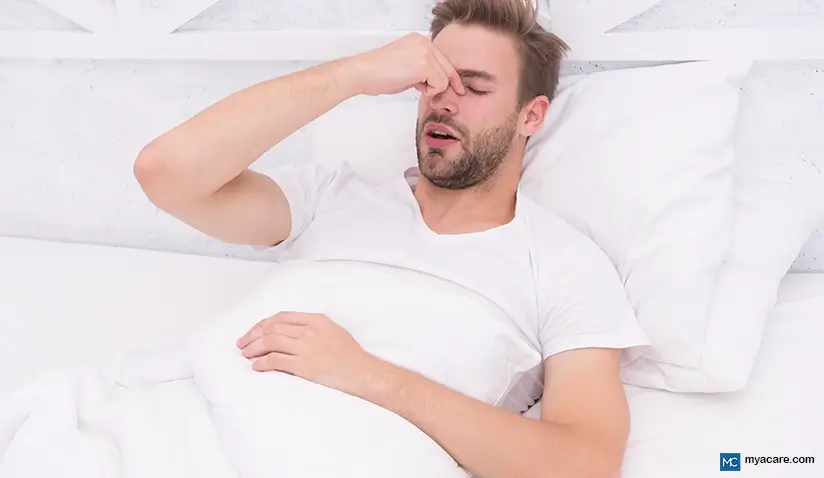What Is Sleep Apnea?

Sleep apnea is a brief halt in breathing which lasts for more than 10 seconds.1 The pause is usually cyclical and momentary, and causes a decrease in oxygen supply in arterial blood, and an increase in carbon dioxide.2 Sleep apnea can severely impact the quality of life by causing day-time sleepiness and fatigue, decreased concentration, memory loss, decreased libido, and irritability.
Types of Sleep Apnea
- Obstructive sleep apnea (OSA): It is a reduction or complete halt in breathing due to partial or complete obstruction of the breathing passage during sleep. This disrupts normal ventilation and sleep patterns. Also called peripheral sleep apnea, OSA is the most common type of sleep apnea. Obstructive sleep apnea is prevalent in ~8% of males and ~3% of females.3
- Central sleep apnea (CSA): Central sleep apnea is caused by malfunction of the respiratory center in the brain, which stops sending signals to the muscles involved in breathing. This leads to repetitive periods of insufficient or absent ventilation.
- Mixed type: The mixed type includes a combination of peripheral and central sleep apnea. This is caused by obstruction of the airway passage and malfunction of the respiratory center in the brain.
How Obstructive Sleep Apnea is Caused
Normally, air enters the respiratory system from nose or mouth, passing through the throat into the lungs. When we sleep, the muscles of the throat are relaxed. This relaxation causes the airway to be narrowed. In individuals with an obstructed breathing passage, this causes further narrowing or closing of the passage. This leads to a decrease in oxygen and an increase in carbon dioxide levels in the blood. In response, the individual wakes up from sleep to reestablish the breathing cycle. Waking up allows the muscles to contract and restores the airway. This cycle repeats once the individual sleeps again.
Signs and symptoms of obstructive sleep apnea5
- Obstructive sleep apnea is associated with loud snoring. These sounds or vibrations are created when air passes through an obstructed airway.
- Excessive day-time sleepiness appears due to disturbed sleep and repetitive instances of waking up in response to disordered breathing.
- Excessive day-time fatigue, unrefreshing sleep, morning headaches, decreased concentration.
- Episodes of gasping for air or choking while sleeping.
- Memory loss, decreased libido, and irritability.
Risk Factors for Obstructive Sleep Apnea
- Obesity: Excess fat deposition, especially around the neck, can cause narrowing of the breathing passage, increasing the risk of obstructive sleep apnea.6
- Demographics: Obstructive sleep apnea is more common in elderly persons. Men are 5-6 times at higher risk of developing OSA than females. Among women, postmenopausal women are at higher risk of developing OSA.6
- Habits: Alcohol consumption and cigarette smoking could aggravate OSA. Alcohol consumption causes suppression of pharyngeal (throat) muscles, which are responsible for breathing. Intake of sedatives such as diazepam (valium) could also exaggerate the condition.6
- Sleeping position: While changing the body position from sitting to lying down, size of the airway decreases, increasing the likelihood of OSA.6
- Genetics: Several reports of families, in which multiple members were found to have OSA, suggest a possible genetic element.5
- Structural abnormalities5
- The presence of small-sized jaw or retruded lower jaw can cause obstruction of the airway by the tongue, soft palate, and soft tissues.
- Large-sized tonsils and adenoids (tissues high up in throat) can block the airway.
- Presence of narrow palate and deviated nasal septum can obstruct the airway.
Treatment of Obstructive Sleep Apnea
Non-surgical approaches7
- Weight reduction can decrease fat accumulation around the neck.
- Avoiding alcohol and sedatives, as these substances can cause further relaxation of throat muscles.
- Change in sleeping position from sleeping on the back to sideways, to avoid the tongue causing a blockage in the airway.
- Use of nasal decongestants and nasal steroids to clear a congested nose.
- Use of splints and oral devices (tongue-retaining devices and mandibular repositioning appliances) to avoid obstruction by the tongue.
- Continuous positive airway pressure (CPAP) therapy: In this therapy, the patient wears a mask which covers the nose and mouth during sleep. The mask is connected to a pump and provides a positive flow of air into the nasal passages in order to keep the airway passage open.8
Surgical approaches
Surgical treatment of OSA includes a wide variety of surgeries such as1
- Correction of the disorders in nose and throat that cause blocking of the air passage (septoplasty, turbinectomy, removal of nasal polyps, surgical treatment of chronic sinusitis).
- Surgery to remove soft tissues such as tonsils and adenoids along with remodeling of other structures in the throat (Uvulopalatopharyngoplasty).
- Permanent tracheostomy, which involves creating an opening in the neck to place a tube into a person's windpipe, is advised in severe cases.
- In individuals with a Body Mass Index (BMI) more than 35 along with comorbidities, bariatric surgery is advised.
~50% of patients with sleep apnea syndrome find surgeries helpful, while ~80% patients with snoring show improvement in symptoms.
Untreated or undiagnosed obstructive sleep apnea can lead to hypertension, heart attack or heart failure, and stroke. Sleep apnea patients are also at increased risk for excessive daytime sleepiness and decreased mental alertness, resulting in reduced quality of life.9
To search for the best healthcare providers worldwide, please use the Mya Care search engine.

Dr. Shilpy Bhandari is an experienced dental surgeon, with specialization in periodontics and implantology. She received her graduate and postgraduate education from Rajiv Gandhi University of Health Sciences in India. Besides her private practice, she enjoys writing on medical topics. She is also interested in evidence-based academic writing and has published several articles in international journals.
References:
Featured Blogs



